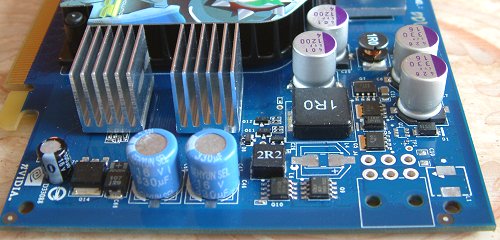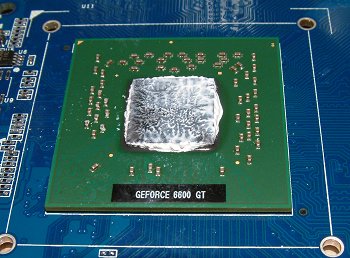Appearance and thoughts

This diminutive card is probably faster and better featured than any previous generation's efforts. That's progress for you. NVIDIA's keen to point out that the performance and features jump between NV30 (GeForce FX) and NV40 (GeForce 6xxx) is the largest since, well, Riva to GeForce. As you will no doubt know, the little slot on the top is NVIDIA's SLI interface that connects two identical cards for increased performance. XFX uses a reference-like cooler and fan combination that's quiet even when placed under load. GeForce 6600 GTs are manufactured on a 110nm process and have around 75-million fewer transistors than the premium NV40 parts. NVIDIA estimates that these wattage-saving measures reduce a regular 6600 GT's power draw to around 50w when under load. That, in conjunction with PCI-Express X16 power-handling specification of around 75w, means there's no need to augment the card with an auxiliary connector.

A close-up shot shows just where that auxiliary power connector would be positioned. XFX has also taken enthusiast's wishes into account when designing its 6600 GT. Four tall RAMsinks are epoxied on to the GDDR3 RAM underneath. You'd question the need to do so if regular 2ns GDDR3 (1000MHz) RAM was specified. XFX. however, has decided that the most effective method of differentiating its card from the pack is to run with 1.6ns-rated chips, probably from Samsung, which equates to a default memory speed of no less than 1200MHz; the fastest I've seen yet. In fact, a perusal of this card's basic specs confirms that it ships with 128MB of GDDR3 RAM run at 1200MHz; a full 20% faster than most other's. Hell, it's faster than a GeForce 6800 Ultra's, too. Top marks to XFX for going the extra mile. I wonder who will be the first partner to opt for Samsung GC-14 GDDR3 chips. That's an effective 1400MHz!.

XFX has applied a generous measure of thermal paste on the NV43 core. Remember that it's an 8-pipe, 4 ROP architecture that's fed by a 128-bit memory interface. 3 vertex shaders give it half a GeForce 6800 GT's shading power on a clock-for-clock basis. The cooler has four spacers to ensure it makes decent contact with the raised core. ATI achieve the same end by using a shim.

A second difference between this card and the rest is the use of dual DVI connectors. The status quo for 6600 GTs is to have a single DVI interface, a regular HD15 connector and S-Video for either VIVO or just plain video-out. I'm especially pleased that XFX has gone with this arrangement. Running a couple of DVI-capable TFT panels is no great shakes today, and your eyes will thank you for hooking up both via this preferred interface. A look at the back of the card shows no VIVO ASIC, so it's just video-out on this model.
XFX's 6600 GT certainly makes a strong hardware case for your money, let's see if the accompanying bundle matches this initial promise.









